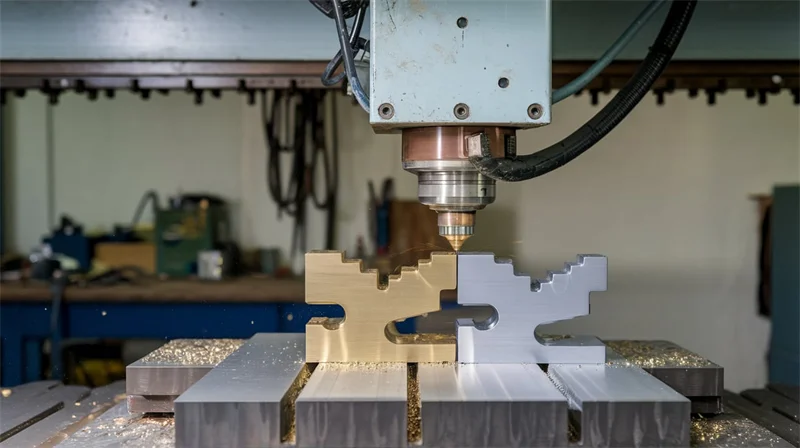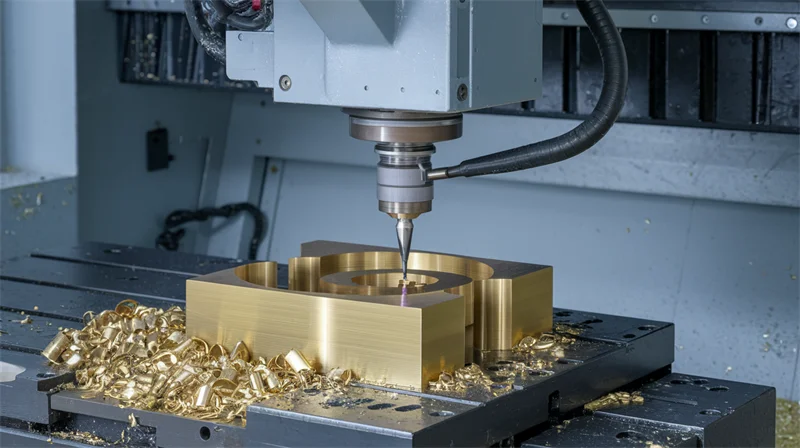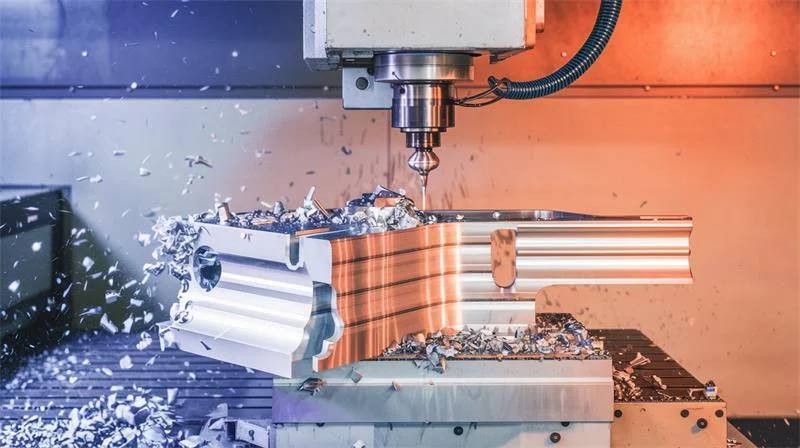Best brass and aluminium grades for CNC machining
In CNC machining, choosing the right material grade is crucial to the success of the project. Different materials have different mechanical properties, machining difficulty and cost, which will directly affect the quality and production efficiency of the final product.
Specific introduction to the characteristics of common brass grades such as 360 brass and 385 brass, and aluminum grades 6061, 7075 and 2024 aluminum. Point out their advantages and disadvantages in rolling and milling processes, so as to help readers choose the best material to complete the project.
This article aims to provide reference for design and production by comparing the performance of different materials in CNC machining, and assist in the perfect completion of the project.

Best brass grades for CNC machining
C360 (Free-cutting brass)
C360 (Free-cutting brass): This is the gold standard for brass CNC machining. C360 brass is often called free-cutting brass, containing 60% copper and 40% zinc. It is characterized by excellent cutting properties, super processing performance, and minimal tool wear. But the price is higher. , so it is very easy to machine. It is ideal for brass parts that require intricate details and smooth surfaces
C353 (engraving brass)
If you are making decorative pieces, such as plaques, nameplates, or jewelry, C353 is your first choice. It has a fine-grained structure and is ideal for engraving and etching. It contains 58% copper, 39% zinc, and 3% lead. The addition of lead makes it harder and more wear-resistant. Used for various engraving and machining workpieces that require delicate handling that tests tool life. It has poor cutting properties and requires the selection of appropriate speed and feed parameters. In addition, it polishes very well and can provide a high-quality appearance to your finished product. This makes it the first choice among CNC machining brass grades.
C385 (Architectural Bronze)
For projects where strength and durability are critical, it contains 85% copper and 15% zinc. It is very hard and wear-resistant and is often used for architectural art sculptures or artefacts. This is a high-copper alloy that is extremely difficult to machine. It is only suitable for workpieces that require a high-quality appearance. It is tougher than C360, but still has good machinability, making it suitable for structural components and heavy brass parts.
The best aluminum grade for CNC machining
| 6061 | 7075 | 2024 |
| 95.8% aluminum – 98.6%, zinc 0.25-0.45%, magnesium 0.8-1.2%, copper ≤0.25%, other total ≤0.15% | Contains 86%-92% aluminum, 1.2%-2% zinc, 1.6%-2.5% magnesium, copper ≤1.3%, other total ≤0.5% | Contains 91%-95% aluminum, 3.8%-4.9% copper, 0.1% magnesium, zinc ≤0.25%, other ≤0.15% |
| Good mechanical properties, low cost, easy cutting, suitable for processing various general structural parts | Higher strength than 6061, but difficult to process, requiring better tools and parameter settings | Has excellent fatigue resistance, but the processing difficulty is between 6061 and 7075 |
| Strong corrosion resistance, good protective layer performance | Suitable for heavy-duty parts requiring high strength | Suitable for air force and marine structural parts that require corrosion resistance and long-term use |
Essential Tips and Techniques for CNC Machining of Aluminum and Brass

Aluminum and brass are popular choices for CNC machining, but each material has its own characteristics. Learn the best ways to machine these metals to get the job done quickly and produce top-notch parts. Here are some key aspects to keep in mind when machining brass and aluminum.
Machining Brass Alloys
Brass is a well-loved material in the machining community for its ease of use and attractive surface. However, there are some key tips and techniques to keep in mind to get the most out of brass CNC machining.
Manage Heat and Rust
- Heat Management: Brass generates a lot of heat during machining, which can lead to work hardening. To mitigate this, use lower spindle speeds (about 300-400 RPM) and smaller depths of cut. This helps preserve the characteristics of the brass alloy.
- Prevent Tarnish: Brass tarnishes quickly when exposed to air. Apply a protective coating or polish the surface immediately after machining to preserve its appearance.
Optimize Tool Selection
- Specialized Tools for Nonferrous Metals: Using tools designed for nonferrous metals, such as carbide or cobalt drills, can achieve cleaner cuts and longer tool life, which is critical for brass CNC machining.
- Thread Forming Taps: For brass threading, choose thread forming taps instead of standard taps to reduce the risk of damaging the threads, which is an essential step in the CNC brass machining process.
Effective Lubrication
Cutting Fluid: Using a high-quality cutting fluid can greatly improve surface finish and extend tool life. It helps dissipate heat and reduce friction, which is critical for brass parts.
Workholding Techniques
Secure Fixtures: Properly securing brass workpieces is critical to avoid vibration and chatter, which can negatively affect the surface finish of brass parts. Use a stable clamp or vise to hold the material securely.
Brass is an alloy of copper and zinc that is widely used for decorative hardware, fittings, and engravings.
Its excellent corrosion resistance makes it suitable for a variety of applications, but be aware of stress corrosion cracking, especially in ammonia or humid environments.
Machining Aluminum
Aluminum stands as a highly versatile material, esteemed in the realm of CNC machining owing to its exceptional lightweight properties and remarkable machinability. However, achieving optimal results when working with aluminium necessitates the adoption of specific techniques and considerations that cater to its unique characteristics.

Controlling Heat and Chip Formation in Aluminum Machining
To harness the full potential of aluminum in CNC machining, it is imperative to meticulously manage heat and chip formation. Firstly, employing high spindle speeds is crucial. Given aluminum’s relatively low melting point, spindle speeds ranging from 800 to 1200 RPM are ideal. These elevated speeds facilitate the production of finer chips and significantly mitigate the risk of chip welding, thereby enhancing the overall quality of the machined surface. Additionally, ensuring efficient chip evacuation is indispensable. A robust chip evacuation system within the CNC machine prevents chips from re-welding to the workpiece, thereby maintaining the integrity of the machined surface.
Tool Selection and Maintenance for Aluminum Machining
The choice and maintenance of tools play a pivotal role in achieving superior machining results with aluminum. Sharp carbide tools are recommended for their ability to prevent the formation of built-up edges (BUE) and produce cleaner, smoother surfaces. Regular inspection and timely replacement of tools are essential to sustain cutting efficiency and extend tool life. Furthermore, the use of coolant is highly advisable. Flood coolant effectively cools the tool and workpiece, preventing thermal expansion and ensuring a consistent surface quality. This practice not only enhances the machined surface but also prolongs the lifespan of the cutting tools.
Workholding and Vibration Control in Aluminum Machining Processes
Stable work holding and vibration control are paramount in aluminium machining to achieve precision and accuracy. Stable workholding is essential, as aluminium, similar to brass, is prone to vibration and chatter. Utilizing soft jaws or clamps that securely hold the workpiece without causing deformation is crucial. Moreover, implementing vibration reduction techniques can further improve the surface finish and tool life. Techniques such as the use of vibration-damping compounds or supports should be incorporated to minimize vibrations and ensure a smooth, defect-free machined surface.
Applications and Grades of Aluminum in CNC Machining
Aluminum’s excellent strength-to-weight ratio and good corrosion resistance make it a preferred material in various industries, including aerospace, automotive, and consumer electronics. Specific grades such as 6061 and 7075 are widely used, each offering unique properties tailored to different applications. Grade 6061, known for its versatility and ease of machining, is ideal for structural components in aerospace and automotive applications. Conversely, Grade 7075, with its higher strength and hardness, is suited for high-stress applications requiring superior mechanical properties. By selecting the appropriate grade and employing the aforementioned techniques, CNC machinists can fully exploit the potential of aluminium, achieving unparalleled precision and quality in their machined components.
FAQ LIST
What are the key differences between brass and aluminium?
Brass is an alloy of copper and zinc, while aluminium is a lightweight metal. Brass is stronger but harder on tooling, while aluminium machines are faster but can be softer.
Can both materials be machined on a CNC machine?
Yes, both brass and aluminium can be machined on a CNC machine. However, brass puts more stress on tooling due to its strength. Sharp, coated carbide tools designed for machining metals are recommended.
Which is better for prototypes?
Aluminum is often a better material than brass for prototypes as it machines quicker. This makes it ideal for iterating designs faster. However, brass prototypes may hold up better to testing and wear.